Indigenous Americans have had a unique cultural history. As modern Americans gain a greater understanding for the importance of awareness, equity, and representation, many struggle with the proper way to acknowledge the special story of our Native ancestors.
The prevailing opinion seems to be that it cannot be done and should not be done; to suggest otherwise is often grounds for hostility and violence. This treatment of Indigenous culture and symbolism as a taboo subject is nothing new in our country. The very first settlers of colonial America sought to ban Native American ceremonies, dances, and other forms of cultural expression on the grounds of religion. Bible scholars felt just in suppressing the religious freedoms of those whom they deemed ‘savage’ in order to ‘save their mortal souls’. For decades, boarding schools were established and operated to forcibly sever the ties between Native youth and their traditional attire and language. American educators felt just in their mission to ‘kill the savage and leave the man’ by punishing Native children for practicing their ancestral ways. Why is it, that in an age of enlightenment and progressive opinions, that we seem to regress on the issue of Native American cultures?
Our mission at Honor the Chief Society is to challenge the status quo and demand a more nuanced approach to the conversation surrounding Native American culture, history, and symbolism. We believe that treating the subject as taboo only serves to worsen the divide that we feel in our country today. The bans and edicts against Native names and images only serve to further limit the awareness and representation that modern Indians seek. Instead of burying the past and destroying opportunities for the future, we should instead be asking ourselves how we can do this right. For many, hiding our history may be the easy way out. We choose to honor our history, and challenge institutions throughout the nation to ask themselves how they can do better.
This challenge does not come without its fair share of resistance. There are many in this country who seek to put a definitive end to the problematic nature of Native names, images, and symbols through dangerous activism and permanent bans. If your community has been targeted by this radical movement, please reach out and join our effort. If you have a town or team organization that uses Native imagery and is concerned about the growing pressure being ignited by these hate groups, we want to work with you to ensure that you are able to keep using Indigenous symbolism in an honorable and respectful way. Together, we can unite to defend the pride, spirit, and truth that has guided us for decades. Together, we can move past the lost battles, and make a stand in the larger war.
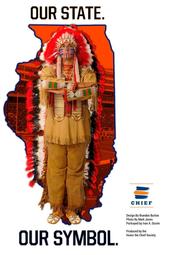 Our organization was founded in Champaign, Illinois in the early 1990s, but the story of our mission dates back much further. Centuries ago, the upper Midwest was home to several tribes, that include but are not limited to the Kickapoo, Mascoutin, Mesquaki, Miami, Odawa, Ojibwe, Piankashaw, Potawatomi, Sauk, and Wea. Many of these tribes had their own cultures, customs, and languages, sometimes even clashing with other tribes over these differences. However, some of these tribal Nations, the Cahokia, Tamaroa, Kaskaskia, Michigamea, and Peoria, to name a few, saw fit to put aside their differences by coming together to form a loose confederation. In the Algonquin language that many of these tribes shared, the Native inhabitants of the region were collectively known as “ih-LYNN-o-ah.” Together with some effort, these tribes were able to coexist and share the land to construct an amazing cooperative society. Today, locations such as Cahokia Mounds and Starved Rock still offer insights for those interested in learning about various early Native cultures in the region. Over time, French settlers in the region influenced the pronunciation of the state to its present form "Illinois". In 1818, Illinois became the name of our nation’s 21st state; the name recognizing its collective inhabitants.
Our organization was founded in Champaign, Illinois in the early 1990s, but the story of our mission dates back much further. Centuries ago, the upper Midwest was home to several tribes, that include but are not limited to the Kickapoo, Mascoutin, Mesquaki, Miami, Odawa, Ojibwe, Piankashaw, Potawatomi, Sauk, and Wea. Many of these tribes had their own cultures, customs, and languages, sometimes even clashing with other tribes over these differences. However, some of these tribal Nations, the Cahokia, Tamaroa, Kaskaskia, Michigamea, and Peoria, to name a few, saw fit to put aside their differences by coming together to form a loose confederation. In the Algonquin language that many of these tribes shared, the Native inhabitants of the region were collectively known as “ih-LYNN-o-ah.” Together with some effort, these tribes were able to coexist and share the land to construct an amazing cooperative society. Today, locations such as Cahokia Mounds and Starved Rock still offer insights for those interested in learning about various early Native cultures in the region. Over time, French settlers in the region influenced the pronunciation of the state to its present form "Illinois". In 1818, Illinois became the name of our nation’s 21st state; the name recognizing its collective inhabitants.
The University of Illinois was established in the year 1867 in Urbana, Illinois. Soon after, it began fielding athletic teams named the “Fighting Illini.” The University attributes this nickname to the World War soldiers for whom their football facility, Memorial Stadium, is named. These soldiers understood the importance of comradery in the face of adversity, and so they chose to name themselves after the Native peoples of Illinois that had established the "Illiniwek Confederacy" as part of the history of their home state. The University was as proud then, as it was for many years, to be associated with the Native peoples for whom the state was named. The Illini attributes of strength, courage, and honor were deeply admired and well-respected among the campus culture and surrounding community.
In 1926, two Eagle Scouts, Lester Leutwiler and Ralph Hubbard, combined their extensive knowledge of Indian lore and dance that they learned at the World Boyscout Jamboree in Denmark into the creation of a halftime tradition to honor the Indigenous roots of the state and University. Unlike some depictions, theirs was not created to portray a real person, but rather a high-minded concept of unity. An original dance was crated and performed by Lester Leutwiler, inspired by authentic dance moves learned from his time in Boy Scouts. A common practice in Native art is to never exactly replicate the creation of another artist, and so as Leutwiler designated another student to continue his tradition, small edits were made to the performance. As such, several students at Illinois over the years presented their own unique take on this tradition, done in the style of a traditional “fancy dance,” which is performed to capture attention and provide entertainment.
In the 1990s, when the Honor the Chief Society was first founded, our mission was to educate the University community about the importance of recognizing the state's Native American history. During these early years, our ideologies were modeled after the Peoria Nation of Oklahoma, direct descendants of the Illiniwek Confederation. On the subject of the Chief Illiniwek tradition at Illinois, Don Giles, Chief of the Peoria Tribe in 1995, said, "To say that we are anything but proud to have these portrayals would be completely wrong. We are proud. We're proud that the University of Illinois, the flagship university of the state, a seat of learning, is drawing on that background of our having been there. And what more honor could they pay us?" Supporting Chief Giles was another tribal elder, Ron Froman, who stated that the anti-imagery protesters "don't speak for all Native Americans, and certainly not us." Though our organization was founded in response to this controversy at the University, The Honor the Chief Society is not sponsored, licensed, approved, or endorsed by the University of Illinois.
For nearly a decade, protestors continued their campaign against Native imagery, eventually reaching a breakthrough by influencing the National Collegiate Athletic Association (NCAA). In 2006, the NCAA ruled that schools with Native imagery must get permission from the tribe they were representing or they would be forbidden from hosting post-season tournaments. Though this ruling deemed Native imagery to be inherently "hostile and abusive", it nevertheless left some room for college teams to maintain their Native names, images, and traditions. Schools such as Florida State and Utah were able to partner with local Seminole and Ute tribes, respectively. Additionally, schools like Hawaii and San Diego State were also able to retain their Native imagery, as the indigenous peoples that they represented were not federally-recognized by the US government, an additional caveat of the NCAA ruling. Illinois was a difficult case because their name and tradition represented a loose confederacy of several tribes, rather than just one. Even more so, the term "Illini" was used to represent the collective inhabitants of Illinois, not just a single demographic. Nevertheless, it was again the NCAA that deemed the Peoria Tribe of Oklahoma to be solely responsible for the fate of Chief Illiniwek at Illinois.
Though the Peoria had once supported the University in their attempt to honor Native history, Tribal governments are subject to the same changes in leadership and ideologies as any other governing body. Originally, the Peoria made efforts to abstain from the decision-making process, seeing as the University in question was some 500 miles away from their tribal headquarters in Miami, Oklahoma. The NCAA, however, demanded a definitive vote, in which The Peoria voted against supporting the University's use of Chief Illiniwek as their official symbol. Though this vote was not unanimous (3-2 with 2 abstaining), the issue has not been revisited by decision-makers within the NCAA, Peoria, nor the University of Illinois.
In 2007, the Illinois board of Trustees retired their time-honored symbol of Chief Illiniwek, citing pressure to comply with the NCAA's ruling from the previous year. Critics of the Chief tradition claimed that this move was not enough, and they would not be satisfied until all names, images, and music that could depict or be interpreted as Native American were permanently banned by the University. Our organization maintains the stance that instead of catering to violent demands and treating Native symbolism as a taboo subject, the University should instead revisit their tradition and partner with local tribes to "Honor the Chief" execute their homage in a way that is educational and respectful.
In 2013, Peoria leaders were in talks with partners of our organization, raising the possibility of re-voting on the issue of Native imagery at Illinois, provided the University would partner with their tribe. With the University now in control of its own fate regarding their use of Native symbolism, UIUC Chancellor Phyllis Wise refused to re-open a dialogue. In 2015, Wise resigned the chancellorship prior to the release of emails that Wise had hidden from FOIA requests.
In 2017, UIUC Chancellor Robert Jones announced that the Marching Illini would be banned from playing the “War Chant.” This was viewed as a victory from anti-Chief activists, who have continued their mission to ban from campus any music and imagery that could be associated with Native American culture and history. Subsequently, in 2019, Chancellor Jones made further efforts to appease this faction, announcing a mass ban on all Native American names, images, logos, and music that applied not only to the former Chief Illiniwek tradition, but any use of Native American depictions in official marketing or athletics. This ban is still in place today.
Despite the retirement of the Chief and the ban on Native imagery, the University continues to hold its trademark on their former logo featuring Native imagery and make money from its merchandising. Per an agreement with the University, The Honor the Chief Society is not allowed to use their original logo. Our official stance is that University leaders are being hypocritical by placing a ban on Native imagery, yet continuing to profit on the sale of their "retro" logo that features a depiction of Indigenous culture. We believe this University should relinquish control of the logo to its creator, Jack Davis, so it can be used as intended: representing the proud Indigenous history of Illinois and beyond.
In the years following the controversial NCAA decision, stories began to emerge detailing the efforts of anti-imagery hate groups at Universities across the nation. From Illinois to North Dakota, these activists sought to replicate their success at the college level in other communities, making it their mission to erase history through similar means in professional sports and even local high schools.
Understanding the history and methodology of these activists is crucial in guiding how institutions can and should respond to them in a constructive rather than destructive manner. In almost every instance, those calling for the removal of Native names and images focus on targeting local schoolboards and corporate sponsors, using divisive and hyperbolic language to convince decision-makers that respected Native names and symbols are actually examples of racism and hate-speech. Once their campaign has been established, they identify local community leaders who speak out against them as threats. Targeted community members are frequently attacked through online trolling, character defamation, and even physical violence. Activists will justify their violence, either claiming ideological self-defense, or claiming that their victims are inherently guilty of espousing hate by supporting the continued use of Native names and/or symbols. The result of their handiwork is the forced removal of Indigenous culture and history, with no conversation as to compromise, nor a path forward that recognizes Native imagery in a better or more positive way. By refusing to compromise and relying on violent methods, those calling for the removal of Native history and symbolism should be considered among this generation's most successful domestic terrorists.
We have made it our mission to stand against these violent activists; to give to the community where they seek only to take, and provide education where they thrive on ignorance and misinformation. Today, we recognize that our efforts to "Honor the Chief" in our community marked an early battle in a nationwide war against Native American history, tradition, culture, and symbolism. To this day, we continue to stand proudly in this noble mission of Honor, Respect, and Education.
The “Davis Symbol”
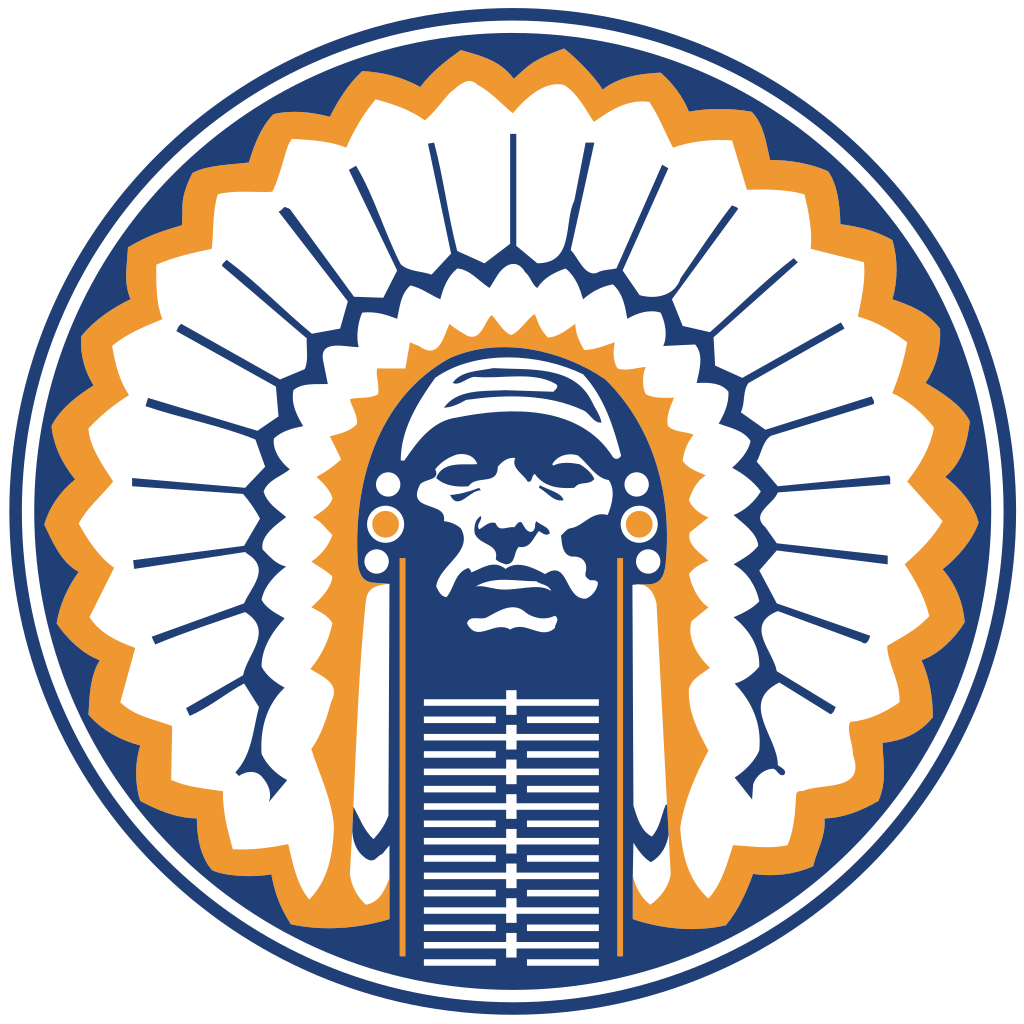 The image here, presented purely for historical context, was created in 1980 by Jack Davis, of Champaign, Illinois. The Davis Symbol was created to depict the Native-inspired traditions at the University of Illinois as a stoic and symbolic icon rather than a mascot. The Davis Symbol serves as an incomparable image of honor and dignity, helping to secure Chief Illiniwek as a noble example of how Native American imagery can be enjoyed and appreciated with respect in our modern society. Regardless of how the symbol is currently used, we recognize that the image of the Davis Symbol stands in a league of its own due to the thought, care, and passion that went into creating a brilliant piece of artwork. After the retirement of the logo in 2007, the ownership of The Davis Symbol continued to reside with the University. In 2008, Mr. Davis sued the University, claiming that ownership of the Chief Logo reverted to him because of the University's new position on Native American imagery. This case was settled, and the University continues to own all rights to the logo. Despite the Chancellor's ban on "music, symbols, branding, marketing, or a mascot that...rely upon Native American images or traditions.", the University continues to produce and profit from merchandise bearing this image today.
The image here, presented purely for historical context, was created in 1980 by Jack Davis, of Champaign, Illinois. The Davis Symbol was created to depict the Native-inspired traditions at the University of Illinois as a stoic and symbolic icon rather than a mascot. The Davis Symbol serves as an incomparable image of honor and dignity, helping to secure Chief Illiniwek as a noble example of how Native American imagery can be enjoyed and appreciated with respect in our modern society. Regardless of how the symbol is currently used, we recognize that the image of the Davis Symbol stands in a league of its own due to the thought, care, and passion that went into creating a brilliant piece of artwork. After the retirement of the logo in 2007, the ownership of The Davis Symbol continued to reside with the University. In 2008, Mr. Davis sued the University, claiming that ownership of the Chief Logo reverted to him because of the University's new position on Native American imagery. This case was settled, and the University continues to own all rights to the logo. Despite the Chancellor's ban on "music, symbols, branding, marketing, or a mascot that...rely upon Native American images or traditions.", the University continues to produce and profit from merchandise bearing this image today.
The HTCS Logo
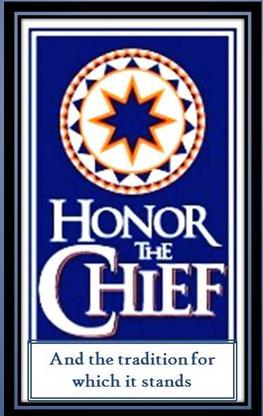
Beginning in 1991, the Honor The Chief Society strives to represent and preserve all of those positive facets of Indigenous imagery from which our communities can draw. However, with so many names and images already in-use and recognizable, we felt it necessary to create a logo that can be linked to the preservation effort of any Native symbols that have come under attack. Our organization logo shares elements of Native American design, without using the imagery of a specific tribe or historical figure. In this way, our logo captures the ability to recognize and be influenced by Native American style, moving forward while acknowledging the past. The circular nature of this logo shows the unending influence of Native peoples of this state. The circle may invoke symbols such as a drum or shield, referencing our mission to be the keepers and protectors of our collective story. The echoes of our past will forever sound in the efforts of our futures, and the sound of our history will never be forgotten as long as a single heart continues to beat to its rhythm.
“Paint-In-Motion”

The “Paint-In-Motion” imagery was created in 2011 by Kurt Wisthuff, of Chicago, Illinois. The symbol is used as the primary logo by the Council of Chiefs, as well as the campus RSO Students for Chief Illiniwek. The practice of wearing face-paint is a common element of many Indigenous cultures. Though an individual may embody positive values in their own right behind the paint, when covered they become part of a tradition that is greater than themselves: no longer representing their individuality, but the collective spirit of their entire community. The tradition of wearing face-paint has any number of intentions, from intimidation to protection. This logo in particular represents safety & protection, the ability to mask the pride of the individual and address the needs of the community as a whole. The “Paint-In-Motion” logo signifies this deep meaning, while also showing that traditions can be ever-evolving, rather than remain motionless in time.
"Continuing Tradition"
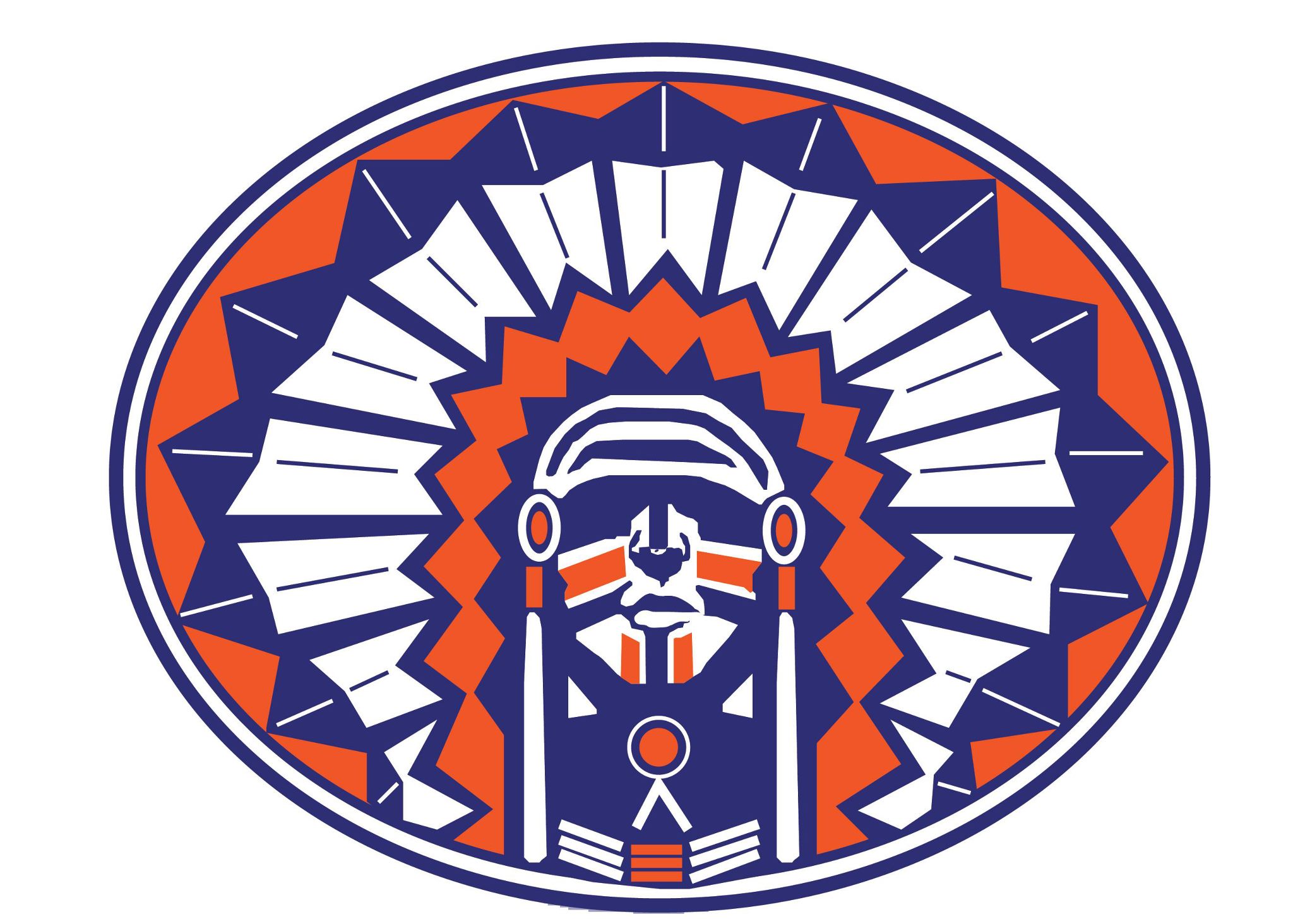 The “Continuing Tradition” image was created in 2011 by Ivan N. Dozier, of Ivesdale, Illinois. Ivan designed the image from a photograph of his son dressed in Native regalia. This logo is special in a number of ways. “Continuing Tradition” portrays a student and was drawn his father, both of whom have Native heritage themselves and were born and raised in the state of Illinois. In this way, “Continuing Tradition” also has a double meaning. Not only does the image help to highlight the modern contributions of Native people in Illinois, but it also recognizes the importance of passing on those values of leadership and tradition to a younger generation. The Continuing Tradition image is not sponsored, licensed, approved, or endorsed by the University of Illinois and is the property of the original creators.
The “Continuing Tradition” image was created in 2011 by Ivan N. Dozier, of Ivesdale, Illinois. Ivan designed the image from a photograph of his son dressed in Native regalia. This logo is special in a number of ways. “Continuing Tradition” portrays a student and was drawn his father, both of whom have Native heritage themselves and were born and raised in the state of Illinois. In this way, “Continuing Tradition” also has a double meaning. Not only does the image help to highlight the modern contributions of Native people in Illinois, but it also recognizes the importance of passing on those values of leadership and tradition to a younger generation. The Continuing Tradition image is not sponsored, licensed, approved, or endorsed by the University of Illinois and is the property of the original creators.
Our "Chief" Tradition:
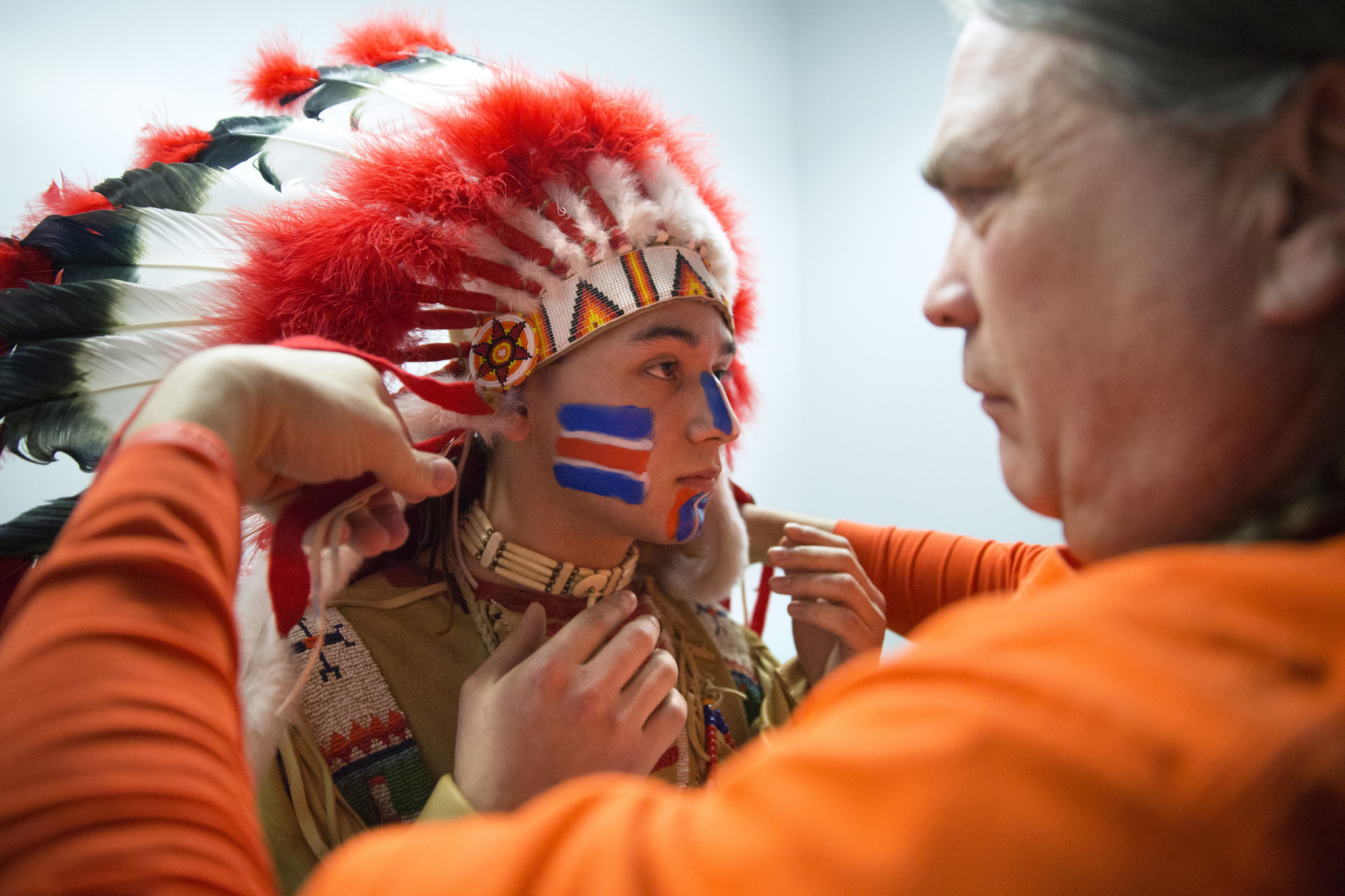 Our organization strives to lead by example by actively using and advocating for the continued use of positive Native imagery. We believe this mission is even more critical at institutions of higher learning, which is why we appoint a student leader to serve in the role of "Chief" for our organization. This symbolic role is held by a current student who has vowed to serve as a protector of Indigenous culture, history, and traditions. Our Chief is given a mission of education and outreach to ensure that those topics remain engaging, meaningful, and well-represented in our local community, as well as nationwide. In our Hall of Honor, we acknowledge students who have served in this role for us, as well as students who have upheld these ideals even prior to our organization's establishment.
Our organization strives to lead by example by actively using and advocating for the continued use of positive Native imagery. We believe this mission is even more critical at institutions of higher learning, which is why we appoint a student leader to serve in the role of "Chief" for our organization. This symbolic role is held by a current student who has vowed to serve as a protector of Indigenous culture, history, and traditions. Our Chief is given a mission of education and outreach to ensure that those topics remain engaging, meaningful, and well-represented in our local community, as well as nationwide. In our Hall of Honor, we acknowledge students who have served in this role for us, as well as students who have upheld these ideals even prior to our organization's establishment.
Chief Osceola:
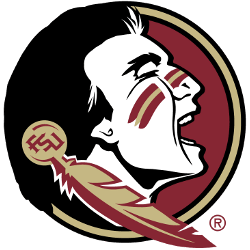 Our organization recognizes the student leaders of Florida State University who serve a similar role in their community. For more than seven decades, Florida State has worked closely, side by side, with the Seminole Tribe of Florida. The council's action was recognition of Florida State's continued collaboration with the tribe to 1) include prominent participation by tribal members in many of the university's most meaningful events, and 2) seek advice and direction to ensure tribal imagery is presented in a respectful manner. Florida State University continues to welcome these opportunities to expose students, faculty, staff and alumni to the Seminoles' history and traditions; reflecting their values as an institution — multiculturalism and diversity. In return, the Seminoles’ culture and lore are kept alive. At Honor the Chief Society, we believe this is the model that organizations should strive for when utilizing Native imagery.
Our organization recognizes the student leaders of Florida State University who serve a similar role in their community. For more than seven decades, Florida State has worked closely, side by side, with the Seminole Tribe of Florida. The council's action was recognition of Florida State's continued collaboration with the tribe to 1) include prominent participation by tribal members in many of the university's most meaningful events, and 2) seek advice and direction to ensure tribal imagery is presented in a respectful manner. Florida State University continues to welcome these opportunities to expose students, faculty, staff and alumni to the Seminoles' history and traditions; reflecting their values as an institution — multiculturalism and diversity. In return, the Seminoles’ culture and lore are kept alive. At Honor the Chief Society, we believe this is the model that organizations should strive for when utilizing Native imagery.
Chief Two Guns White Calf:
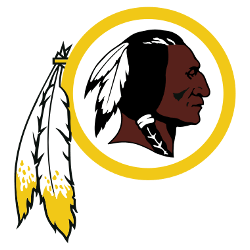 The Washington Redskins primary logo from 1971-2020 was created in close consultation with Native American leaders, including Walter "Blackie" Wetzel, a former President of the National Congress of American Indians and Chairman of the Blackfeet Nation. Years earlier, Mr. Wetzel had been deeply involved with U.S. President John F. Kennedy in the movement for civil liberties, civil rights, and economic freedom for all. In 2014, Mr. Wetzel's son Don commented, “It needs to be said that an Indian from the State of Montana created the Redskins logo, and did it the right way. It represents the Red Nation, and it's something to be proud of.”
The Washington Redskins primary logo from 1971-2020 was created in close consultation with Native American leaders, including Walter "Blackie" Wetzel, a former President of the National Congress of American Indians and Chairman of the Blackfeet Nation. Years earlier, Mr. Wetzel had been deeply involved with U.S. President John F. Kennedy in the movement for civil liberties, civil rights, and economic freedom for all. In 2014, Mr. Wetzel's son Don commented, “It needs to be said that an Indian from the State of Montana created the Redskins logo, and did it the right way. It represents the Red Nation, and it's something to be proud of.”
The Honor the Chief Society is not sponsored, licensed, approved, or endorsed by the University of Illinois.